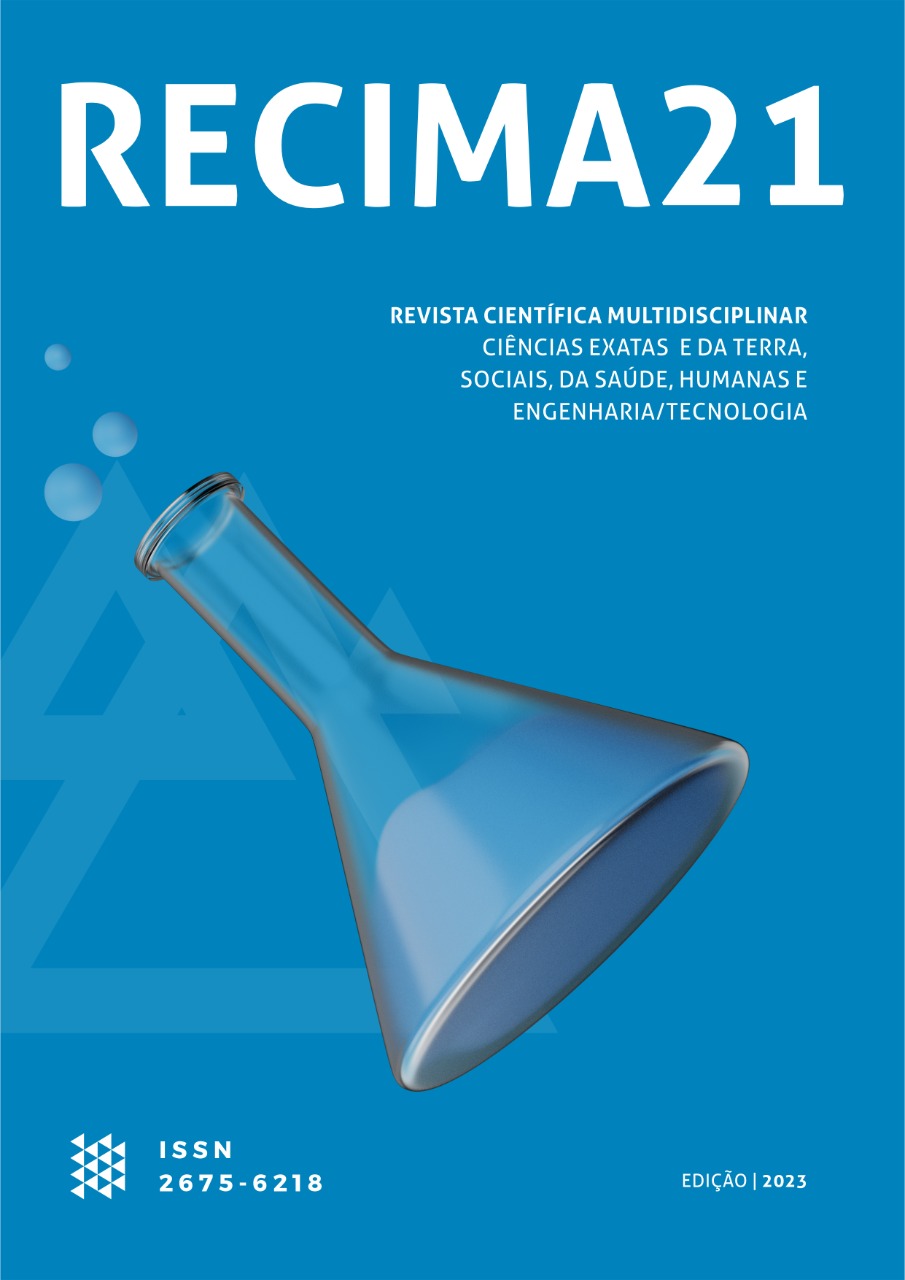ALTERACIONES ANATÓMICAS DE LA NASO-OROFARINGE COMO ETIOLOGÍA DE LA APNEA DEL SUEÑO: UNA REVISIÓN DE LA FISIOPATOLOGÍA Y MÉTODOS QUIRÚRGICOS DEL SÍNDROME
DOI:
https://doi.org/10.47820/recima21.v4i4.2999Palabras clave:
anatomia, Cirurgías, fisiopatologia, apnea, NasofaringeResumen
El Síndrome de Apnea Obstructiva del Sueño se caracteriza por un trastorno respiratorio del sueño, con episodios recurrentes de obstrucción parcial o total de las vías respiratorias superiores. El sobrepeso, la obesidad y el sexo masculino son algunos de los factores de riesgo más extendidos para la AOS. Aunque son factores sumamente importantes, es necesario dar más espacio y notoriedad a otros factores: los anatómicos. La faringe se divide en tres segmentos: nasofaringe; orofaringe, que conduce el aire una vez inhalado; y laringofaringe, responsable de bloquear el paso al esófago cuando se inhala aire. Algunas alteraciones craneofaciales (específicamente en la oronasofaringe) las presentan varios individuos con AOS. Las personas con mayor resistencia al flujo de aire en los segmentos fijos y mayor flacidez del segmento flexible están más predispuestos al colapso de las vías respiratorias superiores, que es un factor de riesgo principal para el desarrollo de AOS, independientemente de la obesidad, la circunferencia del cuello y otras anomalías craneofaciales. El tratamiento quirúrgico está indicado como terapia primaria para la AOS cuando una obstrucción fija corregible quirúrgicamente de las vías respiratorias es responsable de la apnea. En las últimas décadas, ha habido un aumento en los avances de la tecnología quirúrgica, pero se necesita más investigación para cuantificar mejor los cambios en los resultados centrados en el paciente, así como los resultados cardíacos, metabólicos, neurocognitivos y de mortalidad a largo plazo
Descargas
Citas
AKPINAR, M. E. et al. The comparison of cephalometric characteristics in nonobese obstructive sleep apnea subjects and primary snorers cephalometric measures in nonobese OSA and primary snorers. European Archives of Oto-Rhino-Laryngology, v. 268, n. 7, p. 1053–1059, jul. 2011.
ANSELM, Anjali H. et al, Sleep apnea in chronic heart failure, Current Opinion in Cardiology, v. 23, n. 2, p. 121–126, 2008.
BADR, M. S. Pathophysiology of upper airway obstruction during sleep. Clinics in Chest Medicine, v. 19, n. 1, p. 21 – 32, 1998.
BALSALOBRE, R. de A. et al. Tratamento Cirúrgico da Síndrome da Apneia Obstrutiva do Sono com Avanço Maxilomandibular: Revisão Sistemática. Revista Neurociências, v. 24, p. 1–25, 2016.
BUCHNER, N. J. et al. Continuous positive airway pressure treatment of mild to moderate obstructive sleep apnea reduces cardiovascular risk. American Journal of Respiratory and Critical Care Medicine, v. 176, n. 12, p. 1274–1280, 15 dez. 2007.
CAMACHO, M.; CERTAL, V.; CAPASSO, R. Comprehensive review of surgeries for obstructive sleep apnea syndrome. Brazilian Journal of Otorhinolaryngology, v. 79, n. 6, p. 780–788, nov. 2013.
CARRILHO, Leonardo Ennes et al. Rastreamento da síndrome da apneia e hipopneia obstrutiva do sono em hipertensos na Atenção Primária à Saúde. Revista de APS, v. 25, 2022.
CAVALCANTI, Alessandro Leite; SOUZA, Luana dos Santos. Terapêutica da síndrome da apneia obstrutiva do sono: revisão de literatura. Odontol. clín.-cient, p. 189-193, 2006.
CHANDRASHEKARIAH, R.; SHAMAN, Z.; AUCKLEY, D. Impact of Upper Airway Surgery on CPAP Compliance in Difficult-to-Manage Obstructive Sleep Apnea. Archives of Otolaryngology–Head & Neck Surgery, v. 134, n. 9, p. 926, 15 set. 2008.
COLMENERO, C. et al. Sleep apnoea syndrome associated with maxillofacial abnormalities. The Journal of Laryngology and Otology, v. 105, n. 2, p. 94–100, fev. 1991.
CORRÊA, Camila de Castro et al. Obstructive sleep apnea and oral language disorders. Brazilian journal of otorhinolaryngology, v. 83, p. 98-104, 2017.
DE ANDRADE FILHO, E.P de; PEREIRA, FCF. Anatomia Geral, [S.I.]: Sobral, 2015.
DE MOURA, Walter Leal et al. Prevalência do risco da Síndrome da Apneia Obstrutiva do Sono na população adulta de uma capital brasileira. Revista Da Faculdade De Odontologia-UPF, v. 22, n. 3, 2017.
DEKON, Stefan Fiuza De Carvalho et al. Estudo do nível de conhecimento e interesse do cirurgião dentista no diagnóstico e tratamento da síndrome da apneia/hipopnéia obstrutiva do sono (SAHOS). Rev. Odontol. Araçatuba (Online), p. 61-67, 2022.
DIATCHENKO, Luda et al. Genetic basis for individual variations in pain perception and the development of a chronic pain condition. Human molecular genetics, v. 14, n. 1, p. 135-143, 2005.
EPSTEIN, L. J. et al. Clinical guideline for the evaluation, management and long-term care of obstructive sleep apnea in adults. Journal of clinical sleep medicine: JCSM: official publication of the American Academy of Sleep Medicine, v. 5, n. 3, p. 263–276, 15 jun. 2009.
FAIRBURN, S. C. et al. Three-dimensional changes in upper airways of patients with obstructive sleep apnea following maxillomandibular advancement. Journal of Oral and Maxillofacial Surgery: Official Journal of the American Association of Oral and Maxillofacial Surgeons, v. 65, n. 1, p. 6–12, jan. 2007.
FITZPATRICK, M. F. et al. Effect of nasal or oral breathing route on upper airway resistance during sleep. The European Respiratory Journal, v. 22, n. 5, p. 827–832, nov. 2003.
GOZAL, D.; KHEIRANDISH-GOZAL, L. Apneia do sono em crianças - considerações sobre o tratamento. Paediatr Respirat, v. 7, n. suplemento 1, p. s58 –, 2006.
GRYMER, L. F.; ILLUM, P.; HILBERG, O. Septoplasty and compensatory inferior turbinate hypertrophy: a randomized study evaluated by acoustic rhinometry. The Journal of Laryngology and Otology, v. 107, n. 5, p. 413–417, maio 1993.
GUILLEMINAULT, C.; CONNOLLY, S. J.; WINKLE, R. A. Cardiac arrhythmia and conduction disturbances during sleep in 400 patients with sleep apnea syndrome. The American Journal of Cardiology, v. 52, n. 5, p. 490–494, 1 set. 1983.
HAN, Fang; SONG, Wengcai; LI, Jing; et al. Influence of UPPP surgery on tolerance to subsequent continuous positive airway pressure in patients with OSAHS. Sleep & Breathing = Schlaf & Atmung, v. 10, n. 1, p. 37–42, 2006.
HEDNER, J. A. et al. A specific and potent pressor effect of hypoxia in patients with sleep apnea. The American Review of Respiratory Disease, v. 146, n. 5 Pt 1, p. 1240–1245, nov. 1992.
HUDGEL, D. W. The role of upper airway anatomy and physiology in obstructive sleep apnea. Clinics in Chest Medicine, v. 13, n. 3, p. 383–398, set. 1992.
KEENAN, S. P. et al. Long-term survival of patients with obstructive sleep apnea treated by uvulopalatopharyngoplasty or nasal CPAP. Chest, v. 105, n. 1, p. 155–159, jan. 1994.
KENT, D. et al. Referral of adults with obstructive sleep apnea for surgical consultation: an American Academy of Sleep Medicine clinical practice guideline. Journal of clinical sleep medicine: JCSM: official publication of the American Academy of Sleep Medicine, v. 17, n. 12, p. 2499–2505, 1 dez. 2021.
KENT, D. et al. Referral of adults with obstructive sleep apnea for surgical consultation: an American Academy of Sleep Medicine systematic review, meta-analysis, and GRADE assessment. Journal of clinical sleep medicine: JCSM: official publication of the American Academy of Sleep Medicine, v. 17, n. 12, p. 2507–2531, 1 dez. 2021.
KEZIRIAN, E. J.; GOLDBERG, A. N. Hypopharyngeal surgery in obstructive sleep apnea: an evidence-based medicine review. Archives of Otolaryngology--Head & Neck Surgery, v. 132, n. 2, p. 206–213, fev. 2006.
KEZIRIAN, Eric J.; MASELLI, Judy; VITTINGHOFF, Eric; et al. Obstructive sleep apnea surgery practice patterns in the United States: 2000 to 2006. Otolaryngology--Head and Neck Surgery: Official Journal of American Academy of Otolaryngology-Head and Neck Surgery, v. 143, n. 3, p. 441–447, 2010.
LEE, R. W. W. et al. Prediction of obstructive sleep apnea with craniofacial photographic analysis. Sleep, v. 32, n. 1, p. 46–52, jan. 2009.
LEITE, Liliana Patrícia Pinto. Identificação dos factores de risco associados à Síndrome da Apneia Obstrutiva do Sono (SAOS). 2015. Disponível em: <https://recipp.ipp.pt/handle/10400.22/9116>. Acesso em: 16 mar. 2023.
LEMES, Lucas N. A.; GODOY, Luciana B.. Cirurgia no tratamento da síndrome da apneia obstrutiva do sono. Revista Hospital Universitário Pedro Ernesto (TÍTULO NÃO-CORRENTE), [S.l.], v. 15, n. 1, abr. 2016. ISSN 1983-2567.
LI, H-Y. et al. Acoustic reflection for nasal airway measurement in patients with obstructive sleep apnea-hypopnea syndrome. Sleep, v. 28, n. 12, p. 1554–1559, dez. 2005.
LOFASO, F. et al. Nasal obstruction as a risk factor for sleep apnoea syndrome. The European Respiratory Journal, v. 16, n. 4, p. 639–643, out. 2000.
MACKAY, S. G. et al. Modified uvulopalatopharyngoplasty and coblation channeling of the tongue for obstructive sleep apnea: a multi-centre Australian trial. Journal of clinical sleep medicine: JCSM: official publication of the American Academy of Sleep Medicine, v. 9, n. 2, p. 117–124, 1 fev. 2013.
MARCUS, C. L. et al. Obstructive sleep apnea in children with Down syndrome. Pediatrics, v. 88, n. 1, p. 132–139, jul. 1991.
MOORE, K. E.; PHILLIPS, C. A practical method for describing patterns of tongue-base narrowing (modification of Fujita) in awake adult patients with obstructive sleep apnea. Journal of Oral and Maxillofacial Surgery: Official Journal of the American Association of Oral and Maxillofacial Surgeons, v. 60, n. 3, p. 252–260; discussion 260-261, mar. 2002.
MURPHEY, Alexander W. et al. The Effect of Glossectomy for Obstructive Sleep Apnea: A Systematic Review and Meta-analysis. Otolaryngology--Head and Neck Surgery: Official Journal of American Academy of Otolaryngology-Head and Neck Surgery, v. 153, n. 3, p. 334–342, 2015.
NETTER, Frank H. Atlas de anatomia humana. 7° RIO DE JANEIRO: Elsevier, 2019.
PALOMBINI, L. de O. Fisiopatologia dos distúrbios respiratórios do sono. Jornal Brasileiro de Pneumologia, v. 36, n. supl.2, p. 4 – 9, jun 2010.
PANG, Kenny P.; WOODSON, B. Tucker. Expansion sphincter pharyngoplasty: a new technique for the treatment of obstructive sleep apnea. Otolaryngology--Head and Neck Surgery: Official Journal of American Academy of Otolaryngology-Head and Neck Surgery, v. 137, n. 1, p. 110–114, 2007.
PASSOS, U. L. et al. State-dependent changes in the upper airway assessed by multidetector CT in healthy individuals and during obstructive events in patients with sleep apnea. Jornal Brasileiro De Pneumologia: Publicacao Oficial Da Sociedade Brasileira De Pneumologia E Tisilogia, v. 45, n. 4, p. e20180264, 15 ago. 2019.
PILAR, G.; MALHOTRA, A.; FOGEL, R. Mecânica das vias aéreas e ventilação em resposta à carga resistiva durante o sono: influência do gênero. American Journal Of Respiratory And Critical Care Medicine, v. 162, n. suplemento 1, p. 1627 – 1627, 2000.
POLUHA, Rodrigo Lorenzi; STEFANELI, Eduardo Ávila Baena; TERADA, Helio Hissashi. A Odontologia na síndrome da apneia obstrutiva do sono: diagnóstico e tratamento. Revista Brasileira de Odontologia, v. 72, n. 1/2, p. 87, 2016.
RÅNGEMARK, C. et al. Platelet function and fibrinolytic activity in hypertensive and normotensive sleep apnea patients. Sleep, v. 18, n. 3, p. 188–194, abr. 1995.
RIBEIRO, Érika Pinheiro de Oliveira et al. Cirurgia ortognática no tratamento da Síndrome da Apneia Obstrutiva do Sono. Rev. cir. traumatol. buco-maxilo-fac, p. 26-30, 2020.
RILEY, R. W.; POWELL, N. B.; GUILLEMINAULT, C. Obstructive sleep apnea syndrome: A surgical protocol for dynamic upper airway reconstruction. Journal of Oral and Maxillofacial Surgery, v. 51, n. 7, p. 742–747, jul. 1993.
ROITHMANN, R. Testes específicos da permeabilidade nasal. Revista Brasileira de Otorrinolaringologia, v. 73, n. 1, p. 2–2, fev. 2007.
RYAN, C. F. et al. Magnetic resonance imaging of the upper airway in obstructive sleep apnea before and after chronic nasal continuous positive airway pressure therapy. The American Review of Respiratory Disease, v. 144, n. 4, p. 939–944, out. 1991.
SCHELLENBERG, J. B.; MAISLIN, G.; SCHWAB, R. J. Physical findings and the risk for obstructive sleep apnea. The importance of oropharyngeal structures. American Journal of Respiratory and Critical Care Medicine, v. 162, n. 2 Pt 1, p. 740–748, ago. 2000.
SCHWAB, R. J. et al. Upper airway and soft tissue anatomy in normal subjects and patients with sleep-disordered breathing. Significance of the lateral pharyngeal walls. American Journal of Respiratory and Critical Care Medicine, v. 152, n. 5 Pt 1, p. 1673–1689, nov. 1995.
SCHWAB, R. J. et al. Upper airway and soft tissue structural changes induced by CPAP in normal subjects. American Journal of Respiratory and Critical Care Medicine, v. 154, n. 4 Pt 1, p. 1106–1116, out. 1996.
SHAHAR, E. et al. Sleep-disordered breathing and cardiovascular disease: cross-sectional results of the Sleep Heart Health Study. American Journal of Respiratory and Critical Care Medicine, v. 163, n. 1, p. 19–25, jan. 2001.
SHER, A. E.; SCHECHTMAN, K. B.; PICCIRILLO, J. F. The efficacy of surgical modifications of the upper airway in adults with obstructive sleep apnea syndrome. Sleep, v. 19, n. 2, p. 156–177, fev. 1996.
SILVA, Taynara Souza et al. Prevalência de risco de síndrome da apneia obstrutiva do sono e fatores associados. Journal of Health & Biological Sciences, v. 10, n. 1, p. 1-7, 2022.
SMITH, Lindsay A. et al. Auto-titrating continuous positive airway pressure therapy in patients with chronic heart failure and obstructive sleep apnoea: a randomized placebo-controlled trial. European heart journal, v. 28, n. 10, p. 1221-1227, 2007.
SOMERS, V. K.; DYKEN, M. E.; SKINNER, J. L. Autonomic and hemodynamic responses and interactions during the Mueller maneuver in humans. Journal of the Autonomic Nervous System, v. 44, n. 2–3, p. 253–259, 1993.
STOOHS, R.; GUILLEMINAULT, C. Cardiovascular changes associated with obstructive sleep apnea syndrome. Journal of Applied Physiology (Bethesda, Md.: 1985), v. 72, n. 2, p. 583–589, fev. 1992.
STROLLO, P. J. et al. Upper-Airway Stimulation for Obstructive Sleep Apnea. New England Journal of Medicine, v. 370, n. 2, p. 139–149, 9 jan. 2014.
SUNDARAM, Supriya; LIM, Jerome; LASSERSON, Toby J. Surgery for obstructive sleep apnoea in adults. Cochrane Database of Systematic Reviews, 2005. Disponível em: <https://doi.wiley.com/10.1002/14651858.CD001004.pub2>. Acesso em: 16 mar. 2023.
TORTORA, G. J. Corpo Humano: fundamentos da anatomia e fisiologia. 4 ed. Porto Alegre: Artes Médicas, 2000.
TRINDADE, I. E. K.; BERTIER, C. E.; SAMPAIO-TEIXEIRA, A. C. M. Objective Assessment of Internal Nasal Dimensions and Speech Resonance in Individuals With Repaired Unilateral Cleft Lip and Palate After Rhinoseptoplasty. Journal of Craniofacial Surgery, v. 20, n. 2, p. 308–314, mar. 2009.
TEPEDINO, M. et al. Craniofacial morphology in patients with obstructive sleep apnea: cephalometric evaluation. Brazilian Journal of Otorhinolaryngology, v. 88, n. 2, p. 228–234, mar. 2022.
TYAN, M. et al. Obstructive Sleep Apnea in Women: Study of Speech and Craniofacial Characteristics. JMIR mHealth and uHealth, v. 5, n. 11, p. e169, 6 nov. 2017.
VANDERVEKEN, O. M. et al. Evaluation of drug-induced sleep endoscopy as a patient selection tool for implanted upper airway stimulation for obstructive sleep apnea. Journal of clinical sleep medicine: JCSM: official publication of the American Academy of Sleep Medicine, v. 9, n. 5, p. 433–438, 15 maio 2013.
VARELA, J. E.; HINOJOSA, M. W.; NGUYEN, N. T. Resolution of obstructive sleep apnea after laparoscopic gastric bypass. Obesity Surgery, v. 17, n. 10, p. 1279–1282, out. 2007.
VIEGAS, Carlos Alberto de Assis. Epidemiologia dos distúrbios respiratórios do sono. Jornal Brasileiro de pneumologia, v. 36, p. 1-3, 2010.
WEAVER, E. M. Julgando a cirurgia de apneia do sono. Sleep Medicine, v. 14, p. 283 – 283,2010.
WESSENDORF, T. E. et al. Fibrinogen levels and obstructive sleep apnea in ischemic stroke. American Journal of Respiratory and Critical Care Medicine, v. 162, n. 6, p. 2039–2042, dez. 2000.
XIE, A. et al. Exposure to hypoxia produces long-lasting sympathetic activation in humans. Journal of Applied Physiology (Bethesda, Md.: 1985), v. 91, n. 4, p. 1555–1562, out. 2001.
YAGGI, H. K. et al. Obstructive Sleep Apnea as a Risk Factor for Stroke and Death. New England Journal of Medicine, v. 353, n. 19, p. 2034–2041, 10 nov. 2005.
Descargas
Publicado
Cómo citar
Número
Sección
Categorías
Licencia
Derechos de autor 2023 RECIMA21 - Revista Científica Multidisciplinar - ISSN 2675-6218

Esta obra está bajo una licencia internacional Creative Commons Atribución 4.0.
Os direitos autorais dos artigos/resenhas/TCCs publicados pertecem à revista RECIMA21, e seguem o padrão Creative Commons (CC BY 4.0), permitindo a cópia ou reprodução, desde que cite a fonte e respeite os direitos dos autores e contenham menção aos mesmos nos créditos. Toda e qualquer obra publicada na revista, seu conteúdo é de responsabilidade dos autores, cabendo a RECIMA21 apenas ser o veículo de divulgação, seguindo os padrões nacionais e internacionais de publicação.

 Clique para ver detalhes
Clique para ver detalhes 











